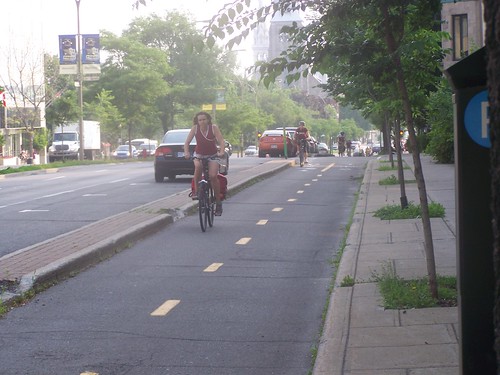Bicycle sharing and rebuilding an ecosystem for bicycling
I really hate the term "bike culture" because the issue is not about "culture" at least the way I define culture ("attitudes") so much as it is about the system that supports or doesn't support, cycling as transportation.
The reason that bicycling has such a high mode share (37% of all trips) in Copenhagen isn't because residents are somehow unique or different, although a relatively flat topography certainly helps.

It's that for 40 years, the various transportation stakeholders in Copenhagen (and Amsterdam, etc.) have created a system that supports bicycling as not only a co-equal mode of transportation--whereas in the U.S., bikes are treated as toys, and for most people--in a country where 96% of commuting trips are made by car, so that while bikes are used, at best it's for weekend recreation and isn't considered a serious mobility option--but to some extent, privileges bicycling rather than the automobile, as a preferred mode of transportation (along with walking and transit).
1. The riders are children, and clearly under the age that is allowed to ride bike sharing bikes. You have to be 16 years old to be able to legally use bicycle sharing bikes in the U.S. And you sign a waiver stating this. So if something happens to those kids, the onus is on the parent. (Of course, the onus is on the user anyway, so maybe younger children should be allowed to use the system.)
The mother said she did call, and "they" said it was ok, but she admitted she didn't tell them how old her daughters are. Clearly she wasn't asked. She obviously was concerned about their safety--the kids were wearing helmets. I didn't ask where she got them. She was defensive when I talked with her--"I'm just trying to be healthy..."
2. I think over time there will be pressure to change the rule, to allow younger people than 16 to ride bike sharing bikes. This creates some issues concerning cost and risk management, as well as raises helmet issues. Most states require children to wear helmets, even if there aren't requirements for adults.
3. Families aren't likely to ride on the streets, mixed in traffic. They were riding on the sidewalk although this is illegal in the central business district. Riding with children, I would have done the same thing.
4. Will bike sharing systems create more pressure to allow bike riding on sidewalks, and therefore adding safety for bicyclists, but at the same time, creating more conflicts with pedestrians.
In my experience, many bicyclists riding on sidewalks ride irresponsibly, riding significantly faster than the 3 to 4 miles per hour that is typical walking pace.
 5. But DC is slowly expanding its network of cycletracks, which provide a protected way to ride "on the street" but separated from both motor vehicles and pedestrians.
5. But DC is slowly expanding its network of cycletracks, which provide a protected way to ride "on the street" but separated from both motor vehicles and pedestrians. While I am not fond of the Pennsylvania Avenue cycletrack, I think the 15th Street cycletrack is coming along (except that the southbound portion generally consists of pavement that is substandard).
The research study of the 15th Street cycletrack is being used to shape the development of the coming L Street NW Cycletrack, which is a key element in developing an integrated network of cycletracks in the core of the city.
6. I was looking at the 15th Street cycletrack on Friday (pictured above), and I was thinking that despite the lack of paved median separating the cycletrack from the roadway, it functions similar to cycletracks in Montreal (pictured below), which so far are the gold standard in North America, in terms of separation and the extent of the network. That's a good thing.

Labels: bicycle sharing, bicycling, transportation planning




0 Comments:
Post a Comment
<< Home